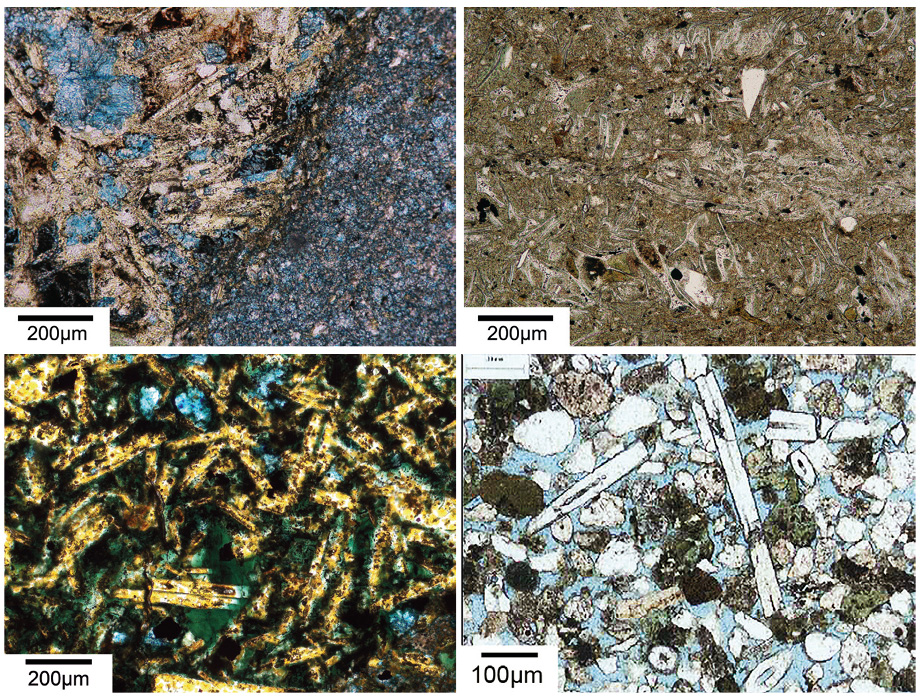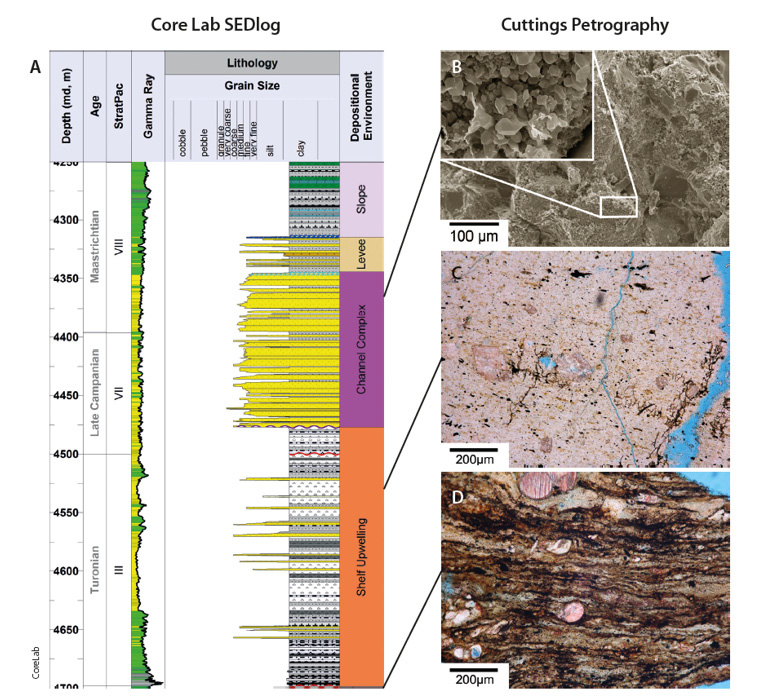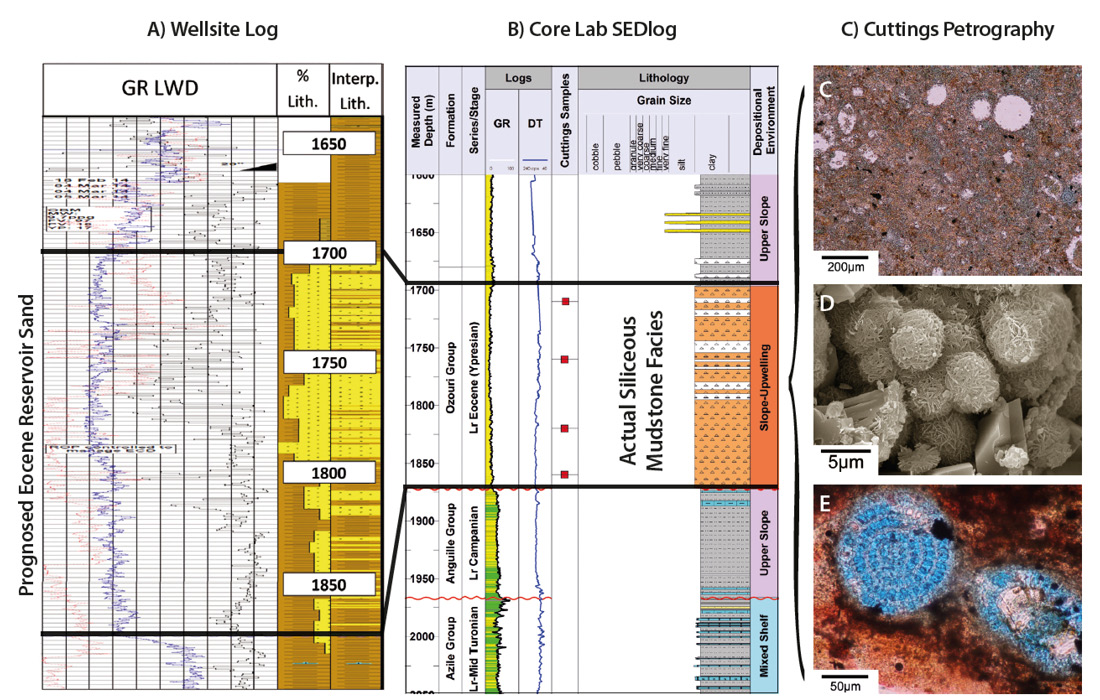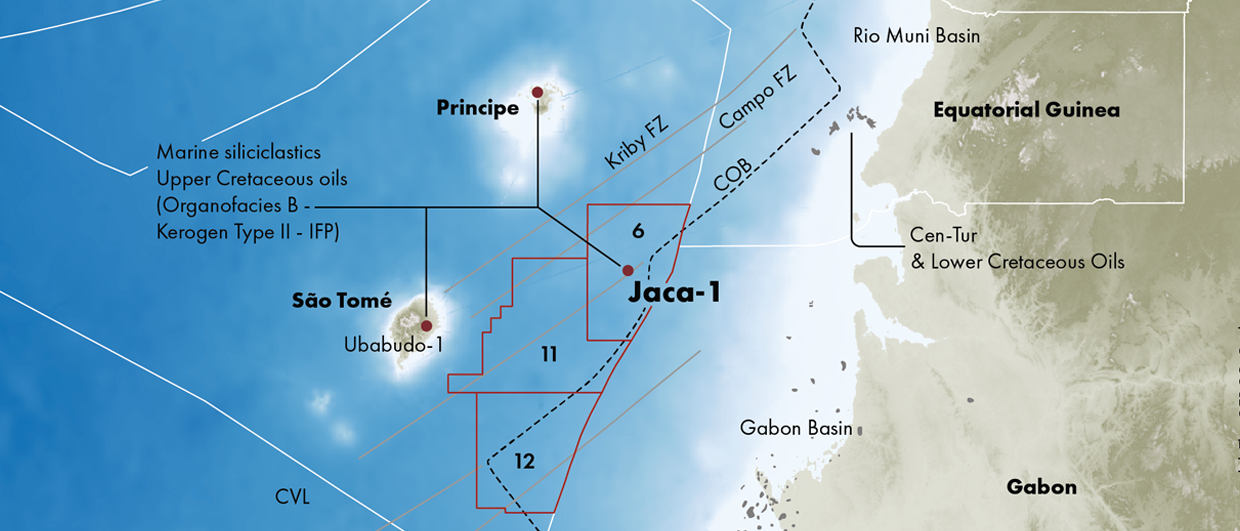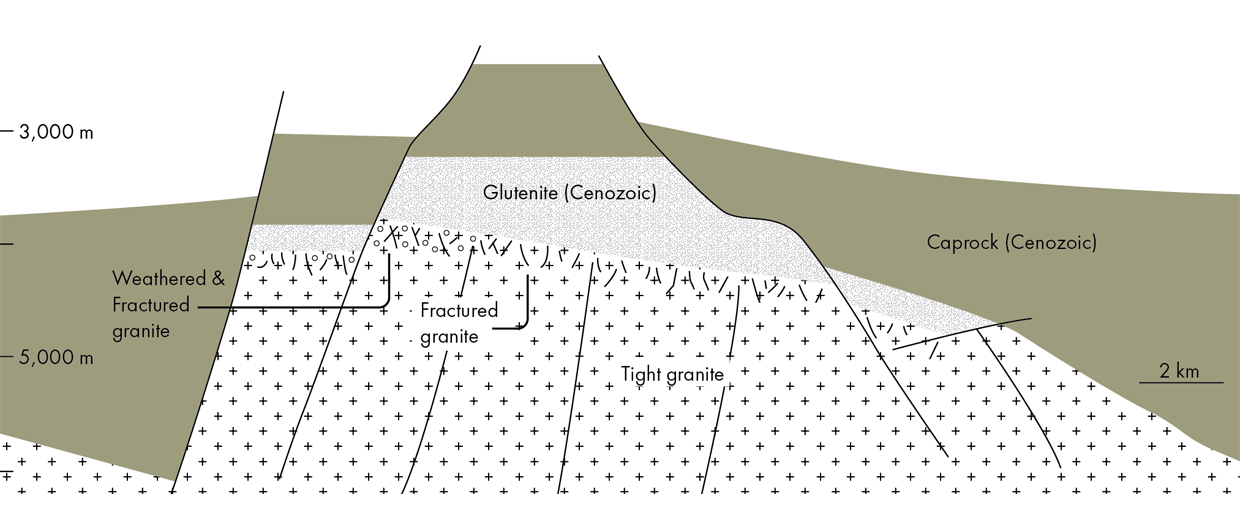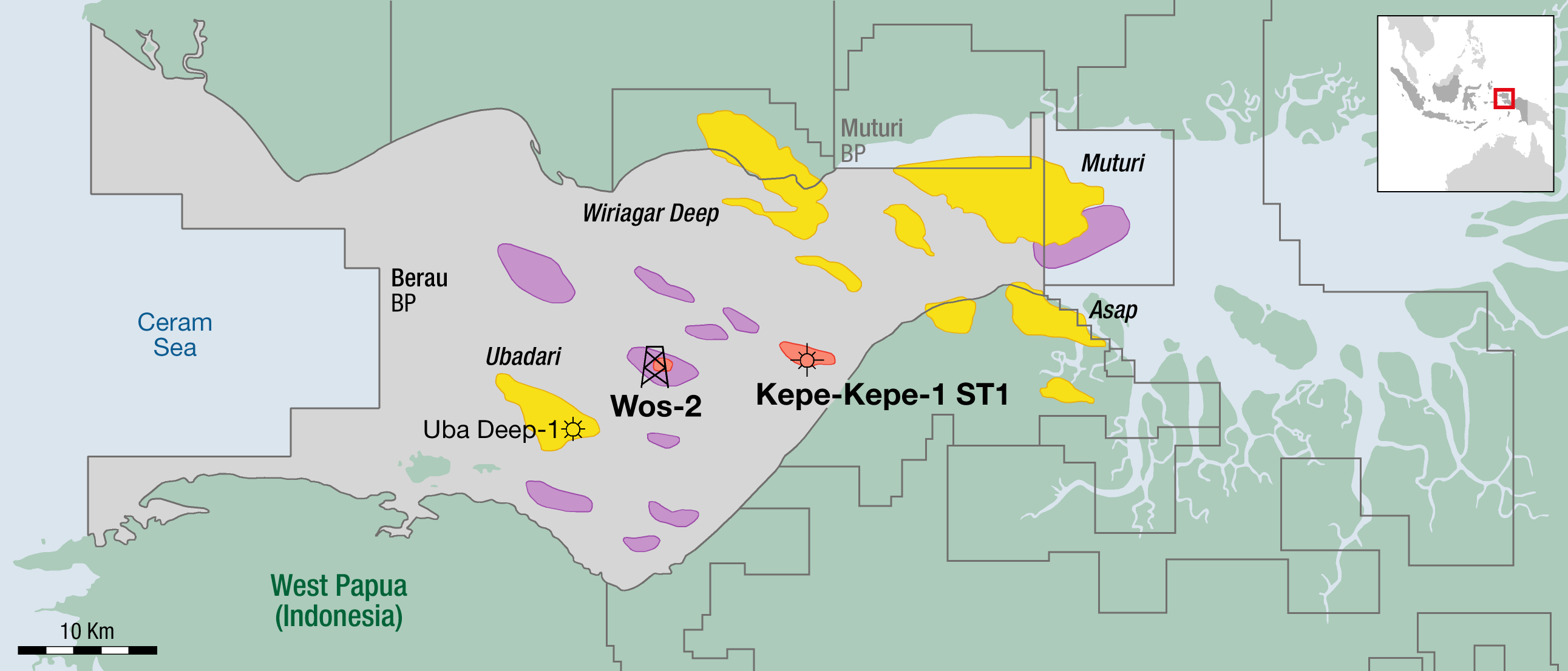Despite the advances in seismic and log lithology interpretation techniques in recent decades, some wells still show major variations between predicted and actual lithologies; in some cases, absence of the prognosed reservoir facies has been the primary factor in well failure. Core Lab’s rock-based approach to regional geological evaluation, which involves revisiting the exploration legacy of core and cuttings material stored in national archives, provides some interesting insights into the persistently problematic rock types – or ‘pitfall petrofacies’ – that have proven difficult, or indeed impossible, to characterize using lithology prediction methods, resulting in the recurring misinterpretation of sandstone and carbonate reservoir targets. In some cases the visual description of drill cuttings and sidewall core samples at the wellsite also fails to recognize the presence of these atypical lithologies.
Thus it appears that some non-reservoir facies can only be fully characterized through detailed integration of petrographic data, taken from sidewall cores and/or drill cuttings, with downhole logs. The reduced acquisition of conventional and sidewall core material in recent years has further exacerbated this issue, as turbo-drilled wells lacking good quality rock material are less likely to provide the detailed lithological information required to flag the raised reservoir risk associated with these complex lithologies prior to follow-on drilling.
Comparison of predicted lithologies and/or composite log data with rock-based petrographic information in multiple sedimentary basins across the Equatorial and South Atlantic margins reveals that the main categories of non-reservoir petrofacies that can be difficult to discriminate from reservoir rocks comprise low gamma siliceous mudstones and altered igneous or hydrothermally-influenced rock types. On a regional scale the lateral and vertical distribution of these petrofacies can be related to variations in intrabasinal topography, oceanic circulation patterns and/or degree of volcanic influence during successive phases of basin evolution.
We discuss some examples of these in more detail below.
Volcanics vs Reservoir Facies
A variety of complex lithologies can develop in basins with igneous influence, particularly when the original intrusive and/or extrusive rocks are partly altered and replaced by authigenic clays, carbonates, zeolites and/or siliceous minerals, or when the host sediments, including both sandstone and carbonate reservoir targets, are altered by associated high-temperature fluids. Examples of volcanically-influenced problematic lithologies can be found at multiple stratigraphic levels in basins across the South Atlantic Margin.
Pre-Salt Carbonate Play: Angola and Brazil
Extensive industry and academic evaluation of core and sidewall core samples from wells drilled in pre-Salt carbonate reservoirs, off shore Brazil and Angola, has provided detailed classification of the diverse carbonate facies encountered in these syn-rift and sag phase volcanically-influenced lacustrine basins. However, in areas with limited well or rock data it still remains a challenge to fully discriminate igneous rocks from carbonate facies on seismic, as illustrated by several deepwater wells in the Kwanza Basin which failed to encounter reservoir facies due to unexpected pervasive volcanic influence throughout the late syn-rift and sag succession (see Figure 1). Although seismic techniques are evolving in order to improve pre-drill recognition of the igneous rock types (Bonet et al., 2019), there is still a need for systematic calibration of downhole logs with rock material in order to map the lateral and vertical distribution of volcanic rocks and high temperature mineralization in relation to the underlying structural topography. Facies mapping suggests that deep-seated fault systems facilitated movement of ascending magmatic hydrothermal fluids and/or mantle gases through reservoir zones in this petroleum province.
Tuffs vs Reservoir Targets: Atlantic Argentina
Unlike the basaltic igneous provinces further north, the Argentina AtlanticMargin was influenced mainly by acid and intermediate volcanism. Syn-rift Jurassic volcanic tuffs here can show high porosity values due to the microporous nature of the microcrystalline matrix and, in the absence of core material, can be difficult to distinguish on logs from early post-rift alluvial fan reservoir facies with abundant reworked volcanic clasts. During Late Cretaceous – Tertiary periods of active andesitic magmatism on this margin, high volumes of volcanic glass were deposited in the marine environment, resulting in markedly increased biogenic productivity of siliceous micro-organisms. Offshore exploration well data here reveals locally complex interbedding of volcanic rocks with diatomites, radiolarites, cherts and deepwater mudstones (Figure 1) that are difficult to differentiate on log signature, particularly in the absence of petrographic calibration. Although most of the observed siliceous rock types represent microporous non-reservoir facies, some Tertiary samples containing high proportions of leached sponge spicules show high measured permeability values and therefore represent legitimate reservoir targets.
Sandstones vs Siliceous Mudstones: Equatorial Transform
The pitfall potential of siliceous mudstones on the West African Equatorial Atlantic Margin has previously been highlighted by Anadarko Petroleum (Brown et al., 2015) in a review of the Campanian ‘quartz claystone conundrum’ that documented dramatic discrepancies between wireline log interpretations of “thick, high quality, quartz-rich deepwater sandstones with effective porosity up to 25%” and wellsite rock descriptions and subsequent laboratory tests that revealed non-reservoir, quartz-rich mudstone facies.
Core Lab’s well-based mapping across this margin from Benin to Liberia reveals an increased prevalence of these silica-rich mudstones in the periods following regional-scale Albian and Santonian uplift events, suggesting that tectonic enhancement of intrabasinal topography may have played a role in the establishment of upwelling silica-rich currents along the paleo shelf-edge during the Late Cretaceous. Siliceous mudstones are less widely developed on the South American Equatorial Margin but similar nutrient-rich upwelling currents have been described from the Late Cretaceous succession along the flanks of the Demerara Plateau on the Suriname Margin (Elrich et al., 2003). Our well data from this region illustrates how interbedding of siliceous mudstones, thin turbidite sandstones and organic shales creates a complex gamma log response that requires systematic calibration against petrographic data (see Figure 2). The chert and porcellanite (siliceous mudstone) facies show lower gamma response than the overlying turbidite (sub-arkosic) sandstones, while, conversely, in the organic-rich mudstones the expected ‘hot shale’ response is suppressed by the presence of interlaminated microporous silica.
Sandstones vs Siliceous Mudstones: Post-Salt Gabon
The presence of chert beds in the Early Tertiary post-salt succession on the Gabon Margin (Ozouri Formation) has been well-documented through decades of drilling along the inboard parts of the margin, but more recent drilling has highlighted the pitfalls associated with distinguishing Eocene channel-fill slope sandstones from thick-bedded cherty mudstones in the deepwater domain. As illustrated in Figure 3, some wells show dramatic differences between the final well composite log based on wellsite visual cuttings description (showing stacked blocky sandstones) and our sedimentological log calibrated with petrographic description of cuttings revealing various porcellanite, radiolarite and chert lithologies. Although the high silica supply on this margin can be correlated with the establishment of South Atlantic upwelling bottom current cells during the Tertiary, there is evidence to suggest increased prevalence of these siliceous facies in the vicinity of volcanic features in the deepwater domain. Discriminating sand fairways from the background siliceous shelf and slope mudstones here requires detailed facies mapping using all available adjacent and inboard well data.
Preventing Pitfalls in Petrofacies Prediction
Our observations from multiple studies across the Equatorial and South Atlantic Margins suggest that some pitfalls in facies prediction can be prevented by applying in-depth knowledge gained from petrographic and sedimentological studies of legacy well cuttings and core material. Problematic low gamma siliceous mudstones appear to be more commonly developed in basins with volcanogenic silica input and basins with pronounced intrabasinal topography, particularly on narrow, fault-bounded continental shelf margins, prone to development of upwelling current systems. In these basins, where the primary exploration target involves slope channel sandstones, it is essential to perform detailed paleogeographic mapping, using rock-based sedimentological data from inboard and adjacent wells tied to intrabasinal structure, in order to define the (often narrow) sand fairways across the shelf. In addition to siliceous facies, volcanically-influenced basins can show a wide range of problematic carbonate and clay-rich lithologies, due to diagenetic alteration and/or hydrothermal mineralization of primary igneous rock types. These ‘secondary lithologies’ can often only be recognized through detailed petrographic analysis and therefore the value of post-drill rock calibration of downhole log lithologies cannot be overstated in terms of reducing reservoir risk for future drilling campaigns.
References:
Bonet, G., Aizprua, C., Hunt, D. and Watton, T. (2019). Carbonate vs Volcanic discrimination in Pre-Salt Brazil. EAGE Pre-Salt Carbonate Conference Poster, Rio November 2019.
Brown, A., Birkhead, S., McLean, D., Towle, P., White, H. and Yafei Wu (2017). The Campanian quartz ‘claystone’ conundrum of the African Transform Margin. In: Petroleum Geoscience of the West Africa Margin. Ed.by Sabato Ceraldi, T., Hodgkinson, R. A. and Backe, G. Geol. Soc, Lond. Spec. Publ., V. 438, 27–48.
Elrich, R.N., Villamil, T. and Keens-Dumas, J. (2003). Controls on the deposition of Upper Cretaceous organic carbon-rich rocks from Costa Rica to Suriname. In C. Bartolini, R.T. Buffler and J. Blickwede (eds.), The Circum-Gulf of Mexico and the Caribbean: Hydrocarbon habitats, basin formation and plate tectonics. AAPG Memoir 79, 1–45.

